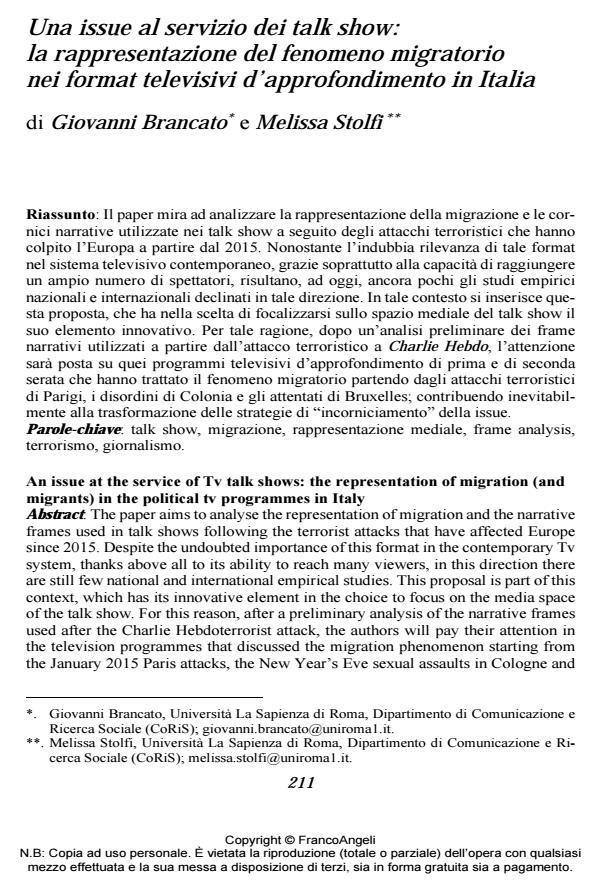An issue at the service of Tv talk shows: the representation of migration (and migrants) in the political tv programmes in Italy
Journal title MONDI MIGRANTI
Author/s Giovanni Brancato, Melissa Stolfi
Publishing Year 2019 Issue 2019/2
Language Italian Pages 18 P. 211-228 File size 295 KB
DOI 10.3280/MM2019-002011
DOI is like a bar code for intellectual property: to have more infomation
click here
Below, you can see the article first page
If you want to buy this article in PDF format, you can do it, following the instructions to buy download credits

FrancoAngeli is member of Publishers International Linking Association, Inc (PILA), a not-for-profit association which run the CrossRef service enabling links to and from online scholarly content.
The paper aims to analyse the representation of migration and the narrative frames used in talk shows following the terrorist attacks that have affected Europe since 2015. Despite the undoubted importance of this format in the contemporary Tv system, thanks above all to its ability to reach many viewers, in this direction there are still few national and international empirical studies. This proposal is part of this context, which has its innovative element in the choice to focus on the me-dia space of the talk show. For this reason, after a preliminary analysis of the nar-rative frames used after the Charlie Hebdoterrorist attack, the authors will pay their attention in the television programmes that discussed the migration phenom-enon starting from the January 2015 Paris attacks, the New Year’s Eve sexual as-saults in Cologne and the 2016 Brussels bombings; which contributed to the trans-formation of the "framing" strategies about the issue.
Keywords: Talk show, migration, media representation, frame analysis, terrorism, journalism.
- The Perceptions About the Immigration Phenomenon Communicated Through Social Media Platforms in Italy Elena Ambrosetti, Sara Miccoli, in Journal of International Migration and Integration /2025 pp.1643
DOI: 10.1007/s12134-025-01246-0 - War-show. Le rappresentazioni mediatiche dell'alterità nell'attuale conflitto russo-ucraino Sara Amato, Jakub Pichalski, in SICUREZZA E SCIENZE SOCIALI 1/2023 pp.133
DOI: 10.3280/SISS2023-001012
Giovanni Brancato, Melissa Stolfi, Una issue al servizio dei talk show: la rappresentazione del fenomeno migratorio nei format televisivi d’approfondimento in Italia in "MONDI MIGRANTI" 2/2019, pp 211-228, DOI: 10.3280/MM2019-002011